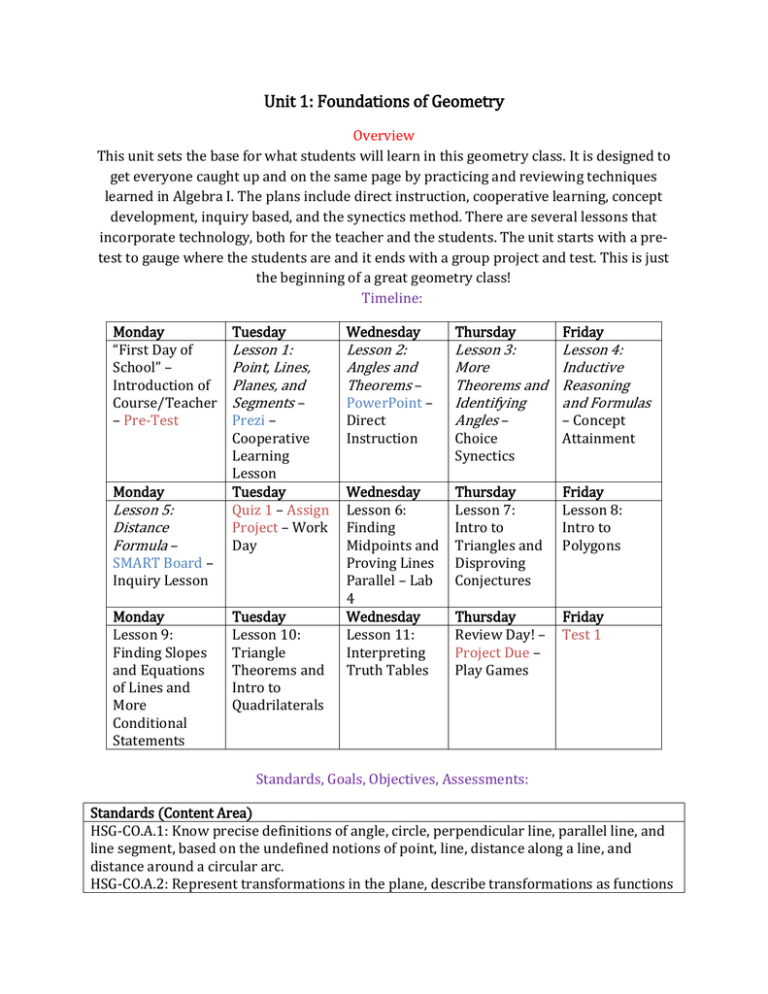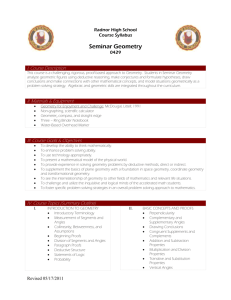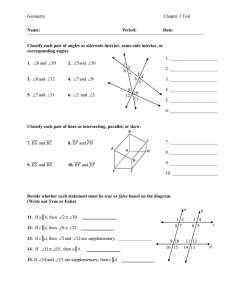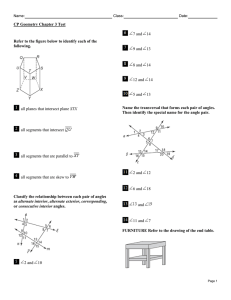here
advertisement

Unit 1: Foundations of Geometry Overview This unit sets the base for what students will learn in this geometry class. It is designed to get everyone caught up and on the same page by practicing and reviewing techniques learned in Algebra I. The plans include direct instruction, cooperative learning, concept development, inquiry based, and the synectics method. There are several lessons that incorporate technology, both for the teacher and the students. The unit starts with a pretest to gauge where the students are and it ends with a group project and test. This is just the beginning of a great geometry class! Timeline: Monday “First Day of School” – Introduction of Course/Teacher – Pre-Test Monday Lesson 5: Distance Formula – Tuesday Wednesday Thursday Friday Lesson 1: Point, Lines, Planes, and Segments – Lesson 2: Angles and Theorems – Lesson 3: More Theorems and Identifying Angles – Lesson 4: Inductive Reasoning and Formulas Prezi – Cooperative Learning Lesson Tuesday Quiz 1 – Assign Project – Work Day SMART Board – Inquiry Lesson Monday Lesson 9: Finding Slopes and Equations of Lines and More Conditional Statements Tuesday Lesson 10: Triangle Theorems and Intro to Quadrilaterals PowerPoint – Direct Instruction Wednesday Lesson 6: Finding Midpoints and Proving Lines Parallel – Lab 4 Wednesday Lesson 11: Interpreting Truth Tables Choice Synectics – Concept Attainment Thursday Lesson 7: Intro to Triangles and Disproving Conjectures Friday Lesson 8: Intro to Polygons Thursday Review Day! – Project Due – Play Games Friday Test 1 Standards, Goals, Objectives, Assessments: Standards (Content Area) HSG-CO.A.1: Know precise definitions of angle, circle, perpendicular line, parallel line, and line segment, based on the undefined notions of point, line, distance along a line, and distance around a circular arc. HSG-CO.A.2: Represent transformations in the plane, describe transformations as functions that take points in the plane as inputs and give other points as outputs. Compare transformations that preserve distance and angle to those that do not. HSG-CO.C.8: Use trigonometric ratios and the Pythagorean Theorem to solve right triangles in applied problems. HSG-CO.C.9: Prove theorems about lines and angles. HSG-CO.C.10: Prove theorems about triangles. HSG-CO.D.12: Make formal geometric constructions with a variety of tools and methods (compass and straightedge, string, reflective devices, paper folding, dynamic geometric software, etc.). HSG-GPE.A.2: Derive the equation of a parabola given a focus and directrix. HSG-GPE.A.3: Derive the equations of ellipses and hyperbolas given the foci, using the fact that the sum or difference of distances from the foci is constant. HSG-GPE.B.4: Use coordinates to prove simple geometric theorems algebraically. HSG-GPE.B.5: Prove the slope criteria for parallel and perpendicular lines and use them to solve geometric problems. HSG-GPE.B.6: Find the point on a directed line segment between two given points that partitions the segment in a given ratio. HSG-GPE.B.7: Use coordinates to compute perimeters of polygons and areas of triangles and rectangles. Standards (Technology) HS.TT.1.1: Use appropriate technology tools and other resources to access information. Unit Goals 1) Students will learn about points, lines, and segments in order to infer about angles. 2) Students will learn about angles in order to infer about triangles. 3) Students will learn about triangles in order to infer about formulas. Unit Objectives Unit Assessments 1) Given the basic definitions of points, 1) Students will work to find a set lines, planes, and angles, students formula for finding the hypotenuse will derive the Pythagorean or missing sides of a triangle in Theorem. several class examples using the information previously learned about triangles. 2) Given the graphical display of lines, 2) Working with fellow classmates, students will derive the distance students will find the distance formula. formula using what they have learned about the Pythagorean Theorem and graphical displays provided by the teacher. 3) Given the definitions and theorems, 3) Students will create a game as a form students will create a game to show of review for the unit test. Working in their understanding of the material pairs, they will choose a topic from in the unit. within the unit to create a detailed game. Before the test, the students will play each other’s games as review. Pre and Post Assessments with Gradebook: Pre-Test: Pre-Test Answers: Post Assessment: Project – Game Instructions: Rubric: Gradebook: Differentiation Sandra Sandra’s strengths include memorization, getting along with peers, and computer skills. She is interested in teaching, computers, and design. However, she needs help understanding figurative language, metaphors, analogies, and symbolic words, understanding major concepts, and completing homework assignments. In this geometry class, and specifically in this unit, Sandra has the opportunity to succeed in many ways. To begin with, a lot of the material taught in this unit is taught by first understanding the basics. The theorems and formulas we use are derived after first knowing what they are made up of. Another area for Sandra to excel is with the game project. She has an opportunity to show off her design skills and let her personality pop through. It is something she can be interested in as well as utilize her partner for any additional needed help. Finally, there is a lot of technology from presentations to class examples that can be sure to grab her attention. She can also use these websites as additional help for her personally on her own time. I think Sandra would benefit by being in my geometry class. Model Lesson Plan Direct Instruction Concept Attainment Type of Differentiated Instruction with Short Description Angles and Theorems About Points, Lines, Planes, and Segments – Students take notes as the teacher writes definitions, illustrations, and example problems on the board. Inductive Reasoning and Using Formulas – Cooperative Learning Synectics Model Starting with patterns, students hypothesize what the relationships will be. Then, given geoboards, students hypothesize to derive formulas. Points, Lines, Planes, and Segments – Students are taught definitions and relationships through a Prezi presentation and are then put into groups. In these groups, they will prepare for a ‘test’ on the information and the group with the highest scores wins a prize. More Theorems and Identifying Angles – Students learn how to identify angles by comparing angles to a rectangles that can be divided into smaller sections. Assessment Section Assessment One: Pre-Test – Multiple Choice Answers: Assessment Two: Quiz 1 – Word Problems Answers: Assessment Three: Project – Game – Instructions: Rubric: Technology Technology One: Lesson One Presentation: http://prezi.com/_vkk3yufr8ip/copy-of-1-2-part-1-points-lines-and-planes/ Technology Two: Lesson Two Closing Activity Websites: http://www.ixl.com/math/geometry/angle-measures http://www.ixl.com/math/geometry/angle-vocabulary http://www.ixl.com/math/geometry/angle-measures Technology Three: Lesson Four Presentation: Technology Four: Lesson Five Presentation Websites: Class Zone http://www.classzone.com/cz/books/geometry_2011_na/book_home.htm?state=NC Math is Fun http://www.mathsisfun.com/geometry/index.html Cool Math http://www.coolmath.com/0-geometry-math-art.html IXL http://www.ixl.com/math/geometry AAA Math http://www.aaamath.com/geo.html My Diigo Site: https://groups.diigo.com/user/knottaway2014 Resources: Five Lessons Lesson One Group Worksheet Answer Key Independent Test Answer Key Homework/Answer Key Lesson Two Closing Activity http://www.ixl.com/math/geometry/angle-measures http://www.ixl.com/math/geometry/angle-vocabulary http://www.ixl.com/math/geometry/angle-measures Lesson Three Lesson Four PowerPoint Worksheet Answer Key Lesson Five Curriculum Plan





